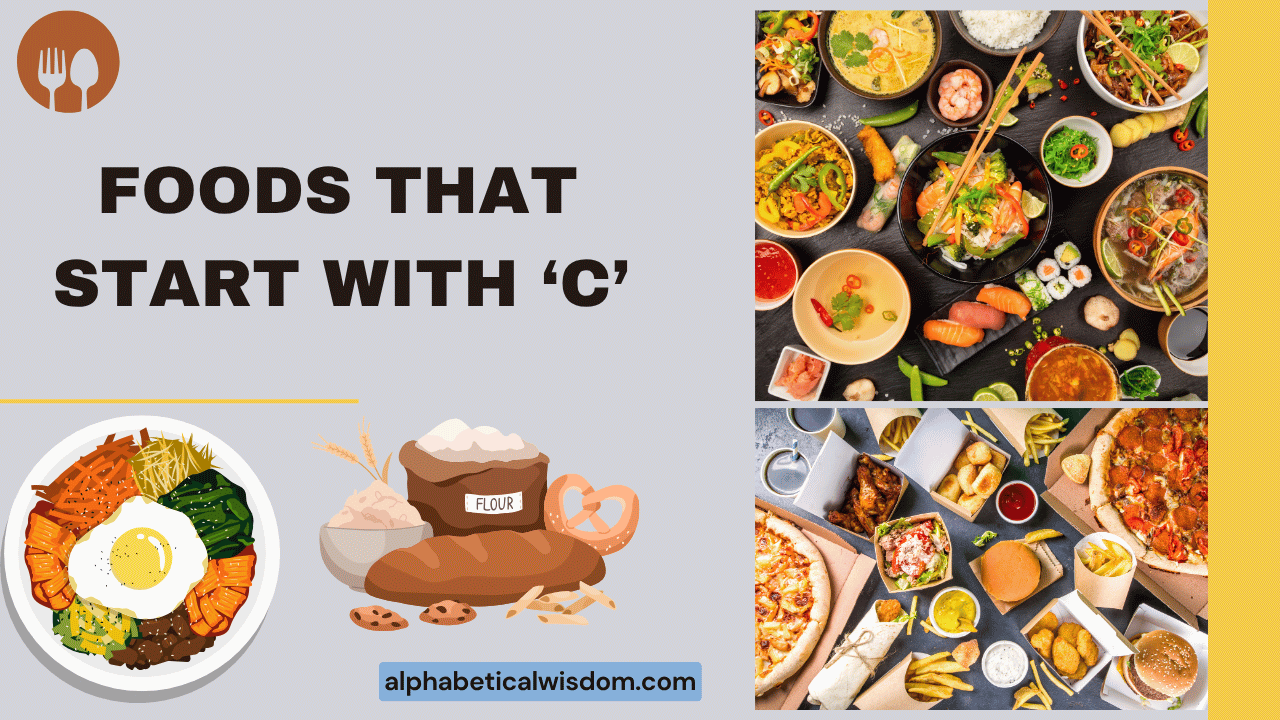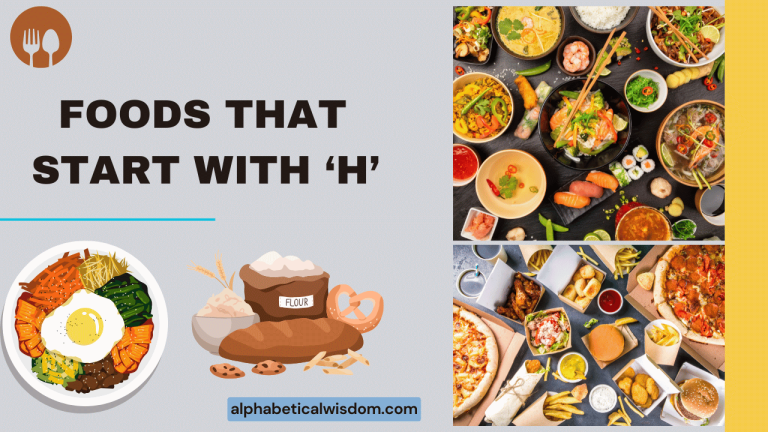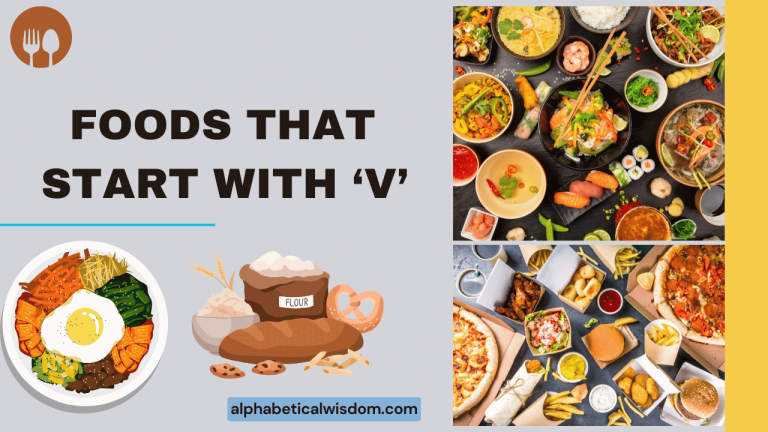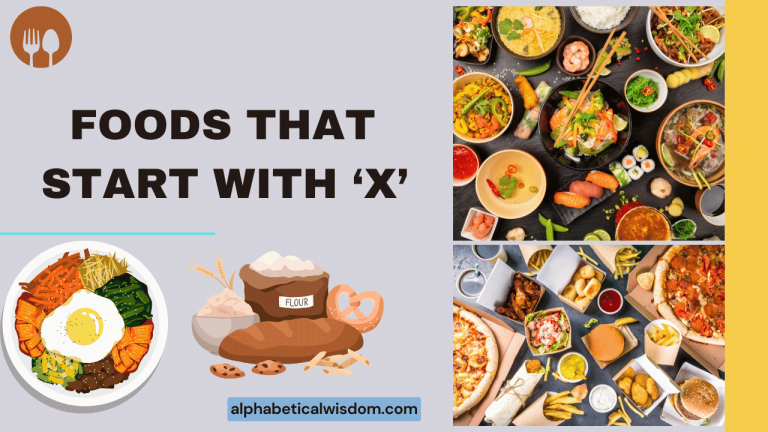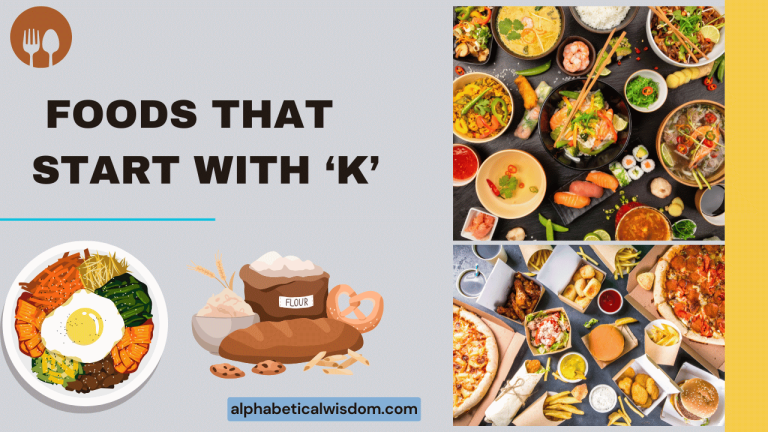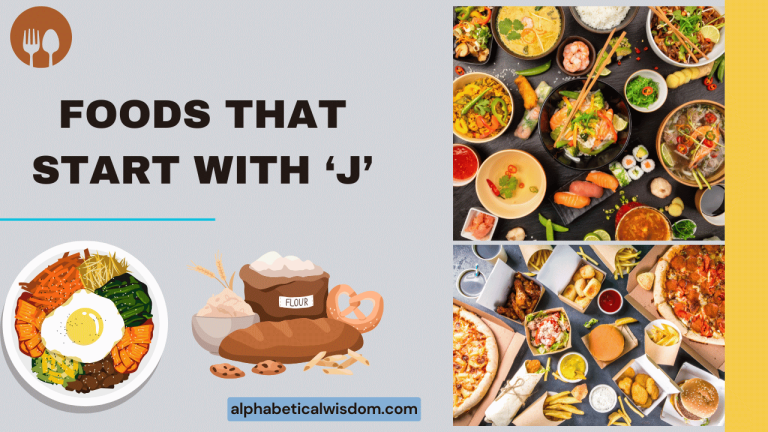Foods That Start With C: A Culinary Grammar Guide
Exploring vocabulary through food is a delicious way to enhance your English language skills. This article focuses on foods that begin with the letter “C,” providing not only a tasty lexical journey but also opportunities to reinforce grammar concepts like nouns (countable and uncountable), articles, and descriptive adjectives.
Whether you’re a beginner or an advanced learner, this culinary-themed lesson will expand your vocabulary and improve your understanding of English grammar. Get ready to embark on a flavorful linguistic adventure!
Table of Contents
- Introduction
- Definition: Foods That Start With “C”
- Structural Breakdown: Nouns and Articles
- Types and Categories of Foods
- Examples of Foods That Start With “C”
- Usage Rules: Countable and Uncountable Nouns
- Common Mistakes
- Practice Exercises
- Advanced Topics: Idioms and Expressions
- FAQ
- Conclusion
Introduction
Learning new vocabulary can be a delightful experience, especially when it’s centered around a topic as universally appealing as food. This article provides a comprehensive guide to foods that start with the letter “C,” offering not only a list of vocabulary words, but also practical insights into related grammar concepts.
Understanding how to use these words correctly in sentences, considering whether they are countable or uncountable nouns, and selecting the appropriate articles are essential for effective communication.
This guide is designed for English language learners of all levels, from beginners who are just starting to build their vocabulary to advanced learners who want to refine their grammar skills and explore more nuanced language use. By focusing on the specific category of foods that start with “C,” we can explore a diverse range of vocabulary while grounding our learning in a tangible and engaging subject.
The combination of vocabulary and grammar will help you to speak and write more confidently and accurately about food and related topics.
The article will cover everything from basic definitions to more complex usage rules, ensuring that you have a solid understanding of the material. We will also explore common mistakes that learners make and provide practical exercises to help you practice and reinforce your learning.
So, let’s dive into the world of culinary vocabulary and discover the many delicious “C” foods that await us!
Definition: Foods That Start With “C”
Foods that start with the letter “C” encompass a wide variety of edible items, ranging from fruits and vegetables to meats, grains, and prepared dishes. These words function primarily as nouns, representing specific items or categories of food. Some are countable nouns, meaning they can be singular or plural and can be counted (e.g., carrot, cookie, cupcake). Others are uncountable nouns, also known as mass nouns, which cannot be counted in the same way and typically do not have a plural form (e.g., cornmeal, couscous, cream). Understanding this distinction is crucial for correct grammar usage, especially when using articles and quantifiers.
The context in which these nouns are used can also affect their grammatical properties. For example, while “coffee” is generally uncountable (e.g., “I drink coffee every morning”), it can be countable when referring to individual servings (e.g., “I ordered two coffees”). Similarly, “chocolate” is usually uncountable (e.g., “I love chocolate”), but can be countable when referring to individual chocolates (e.g., “I ate three chocolates”). This flexibility highlights the importance of paying attention to the specific meaning and context when using food-related nouns.
Furthermore, the use of adjectives to describe these foods adds another layer of complexity and richness to the language. Adjectives like “creamy,” “crispy,” “crunchy,” and “caramelized” can provide vivid descriptions of the taste, texture, and appearance of various “C” foods, enhancing the overall communication.
By mastering the grammar associated with these foods, including noun types, article usage, and descriptive adjectives, you can effectively express your culinary preferences and experiences in English.
Structural Breakdown: Nouns and Articles
Understanding the structure of noun phrases involving foods that start with “C” requires a solid grasp of nouns and articles. Nouns, as previously mentioned, can be either countable or uncountable. Countable nouns have singular and plural forms (e.g., “one carrot,” “many carrots”), while uncountable nouns generally do not (e.g., “some couscous,” not “many couscouses”). The choice of article (a, an, the) depends on whether the noun is countable or uncountable, and whether it is specific or general.
For countable nouns, the indefinite article “a” or “an” is used when referring to a non-specific item for the first time (e.g., “I ate a cookie”). The definite article “the” is used when referring to a specific item or one that has already been mentioned (e.g., “The cookie was delicious”). For uncountable nouns, “a” or “an” is never used. Instead, we use quantifiers like “some,” “much,” “a lot of,” or simply no article at all (e.g., “I want some coffee,” “I like cream in my coffee”).
Here’s a breakdown of the structural elements:
- Article + Noun (Countable, Singular): a carrot, an apple
- Article + Adjective + Noun (Countable, Singular): a crunchy carrot, a crisp apple
- Quantifier + Noun (Uncountable): some coffee, much cream
- The + Noun (Specific): The cake I ate was delicious.
Types and Categories of Foods
Foods that start with “C” can be categorized into various food groups, each with its unique characteristics and culinary uses. These categories include fruits, vegetables, grains, meats, dishes, sweets, and condiments.
Understanding these categories can help organize your vocabulary and make it easier to learn and remember new words.
Fruits
Fruits are typically sweet and fleshy products of plants that contain seeds. Examples of “C” fruits include:
- Cantaloupe: A type of melon with orange flesh.
- Cranberry: A small, tart red berry often used in sauces and juices.
- Cherry: A small, round, sweet fruit with a pit.
- Currant: A small berry, often red or black, used in jams and baked goods.
- Clementine: A small, easy-to-peel citrus fruit.
Vegetables
Vegetables are edible plants or parts of plants, often eaten as savory dishes. Examples of “C” vegetables include:
- Carrot: A root vegetable, typically orange in color.
- Cauliflower: A cruciferous vegetable with a white head.
- Cabbage: A leafy green or purple vegetable.
- Cucumber: A long, green vegetable often used in salads.
- Celery: A stalk vegetable with a crisp texture.
Grains
Grains are seeds of cereal plants, often used as staple foods. Examples of “C” grains include:
- Corn: A cereal grain also known as maize.
- Couscous: A type of pasta made from semolina.
Meats
Meats are animal flesh used as food. Examples of “C” meats include:
- Chicken: A type of poultry.
- Crab: A shellfish with a hard shell and ten legs.
- Cod: A type of fish.
Dishes
Dishes are prepared foods, often combining multiple ingredients. Examples of “C” dishes include:
- Casserole: A baked dish, often containing meat, vegetables, and a sauce.
- Curry: A dish with a sauce flavored with spices.
- Chowder: A thick soup, often made with seafood.
- Crepe: A thin pancake.
Sweets
Sweets are foods high in sugar, often eaten as desserts. Examples of “C” sweets include:
- Cake: A sweet baked dessert.
- Candy: A sweet confection.
- Cookie: A small, sweet baked treat.
- Cupcake: A small cake baked in a cup-shaped mold.
- Caramel: A sweet, brown confection made from heated sugar.
Condiments
Condiments are sauces, spices, or other preparations added to food to enhance its flavor. Examples of “C” condiments include:
- Catsup (Ketchup): A tomato-based sauce.
- Chutney: A spicy condiment made from fruits or vegetables.
Examples of Foods That Start With “C”
This section provides extensive examples of foods that start with the letter “C,” categorized by food group. Each table includes the food item, whether it’s countable or uncountable, and example sentences demonstrating correct usage.
The following table showcases examples of fruits beginning with the letter “C,” along with their countability and example sentences demonstrating their usage in context. Understanding whether a noun is countable or uncountable is crucial for correct grammar, especially when using articles and quantifiers.
| Food Item | Countable/Uncountable | Example Sentences |
|---|---|---|
| Cantaloupe | Countable | I bought a cantaloupe at the market. / We ate two cantaloupes yesterday. |
| Cranberry | Countable | She added a cranberry to her muffin. / I love cranberries in my sauce. |
| Cherry | Countable | He ate a cherry pie. / They picked cherries from the tree. |
| Currant | Countable | She added a currant to the mix. / The recipe calls for dried currants. |
| Clementine | Countable | I packed a clementine in my lunchbox. / My kids love clementines. |
| Cape Gooseberry | Countable | I found a cape gooseberry at the farmer’s market. / These cape gooseberries are delicious in jam. |
| Crabapple | Countable | She picked a crabapple from the tree. / Crabapples are often used to make jelly. |
| Cloudberry | Countable | He found a cloudberry while hiking. / Cloudberries are rare and delicious. |
| Custard Apple | Countable | I tried a custard apple for the first time. / Custard apples have a unique flavor. |
| Cocoa Plum | Countable | I saw a cocoa plum growing in the garden. / Cocoa Plums are native to tropical regions. |
| Cherimoya | Countable | She bought a cherimoya at the exotic fruit stand. / Cherimoyas are also known as custard apples. |
| Christmas Melon | Countable | He sliced a Christmas melon for dessert. / Christmas melons are very refreshing. |
| Caco Fruit | Countable | She used a cacao fruit to make chocolate. / Cacao fruits are the source of chocolate. |
| Ceylon Gooseberry | Countable | I tasted a ceylon gooseberry during my trip. / Ceylon gooseberries have a sweet and sour flavor. |
| Chinese Date | Countable | She ate a chinese date as a snack. / Chinese dates are also known as jujubes. |
| Citron | Countable | He zested a citron for the cake. / Citrons are often used to make candied peel. |
| Cocktail Grapefruit | Countable | I squeezed a cocktail grapefruit for juice. / Cocktail grapefruits are sweeter than regular grapefruits. |
| Concord Grape | Countable | She made jam from a concord grape. / Concord grapes are used to make grape juice and jelly. |
| Cornelian Cherry | Countable | He picked a cornelian cherry from the tree. / Cornelian cherries are used in traditional medicine. |
| Cranberry Bean | Countable | She cooked a cranberry bean in the stew. / Cranberry beans have a unique speckled appearance. |
| Caviar Lime | Countable | He garnished the dish with a caviar lime. / Caviar limes contain tiny juice-filled pearls. |
| Canistel | Countable | I tried a canistel for the first time. / Canistels are also known as eggfruit. |
| Calamansi | Countable | She squeezed a calamansi into her tea. / Calamansi is a type of citrus fruit. |
| Cashew Apple | Countable | He ate a cashew apple as a snack. / Cashew apples are the fruit of the cashew tree. |
| Chokecherry | Countable | She made jelly from a chokecherry. / Chokecherries have a tart flavor. |
| Cipolla Onion | Countable | He added a cipolla onion to the salad. / Cipolla onions are sweet and mild. |
The following table showcases examples of vegetables beginning with the letter “C,” along with their countability and example sentences demonstrating their usage in context. Understanding whether a noun is countable or uncountable is crucial for correct grammar, especially when using articles and quantifiers.
| Food Item | Countable/Uncountable | Example Sentences |
|---|---|---|
| Carrot | Countable | I peeled a carrot for the salad. / She bought several carrots at the store. |
| Cauliflower | Countable | He roasted a cauliflower for dinner. / They grew cauliflowers in their garden. |
| Cabbage | Countable | She made coleslaw with a cabbage. / The farmer grew different types of cabbages. |
| Cucumber | Countable | I sliced a cucumber for the salad. / We planted cucumbers in the vegetable patch. |
| Celery | Countable | She dipped a celery stick in ranch dressing. / He bought a bunch of celery at the market. |
| Collard Greens | Countable | He cooked collard greens with ham hocks. / She planted collard greens in her garden. |
| Chives | Countable | She sprinkled chives on the baked potato. / He grew chives in his herb garden. |
| Chicory | Uncountable | She added some chicory to the salad for a bitter taste. / Chicory can be used as a coffee substitute. |
| Cassava | Countable | She fried cassava chips for a snack. / He harvested cassavas from his farm. |
| Cayenne Pepper | Countable | She added cayenne pepper to the chili for some heat. / He grew cayenne peppers in his garden. |
| Cardoon | Countable | He braised cardoon with olive oil and garlic. / She planted cardoons in the garden. |
| Chinese Cabbage | Countable | She stir-fried chinese cabbage with tofu. / He grew chinese cabbages in his garden. |
| Celeriac | Countable | She mashed celeriac with potatoes. / He bought celeriacs at the farmer’s market. |
| Chayote | Countable | She stuffed chayote with ground meat. / He grew chayotes on his vine. |
| Crookneck Squash | Countable | She sautéed crookneck squash with butter and herbs. / He grew crookneck squashes in his garden. |
| Calabash | Countable | She used calabash to make a bowl. / He grew calabashes on his vine. |
| Chile Pepper | Countable | She added chile pepper to the salsa to make it spicier. / He grew chile peppers in his garden. |
| Corn Salad | Uncountable | She added some corn salad to the salad mix. / Corn salad has a mild, nutty flavor. |
| Cress | Uncountable | She sprinkled some cress on the soup as a garnish. / Cress is often used in salads and sandwiches. |
| Crown Daisy | Countable | She cooked crown daisy in the soup. / He grew crown daisies in his garden. |
| Caigua | Countable | She stuffed caigua with rice and vegetables. / He grew caiguas in his garden. |
| Cardamom | Uncountable | She added some cardamom to the curry for aroma. / Cardamom is a common spice in Indian cuisine. |
| Catsear | Countable | She added catsear to the salad mix. / He grew catsears in his garden. |
| Celtuce | Countable | She stir-fried celtuce with garlic and ginger. / He grew celtuces in his garden. |
| Chamomile | Uncountable | She made tea with some chamomile flowers. / Chamomile is known for its calming properties. |
| Chevil | Uncountable | She sprinkled some chervil on the salad. / Chervil has a mild anise-like flavor. |
The following table provides examples of dishes, sweets, and condiments that start with the letter “C.” These examples will further illustrate the usage of countable and uncountable nouns in the context of food.
| Food Item | Countable/Uncountable | Example Sentences |
|---|---|---|
| Casserole | Countable | She baked a casserole for the potluck. / They brought three different casseroles to the party. |
| Curry | Countable/Uncountable | He ordered a curry at the Indian restaurant. / I like curry with chicken. |
| Chowder | Countable/Uncountable | She made a chowder with clams and potatoes. / I love chowder on a cold day. |
| Crepe | Countable | He ordered a crepe with Nutella and bananas. / They served several crepes at the breakfast buffet. |
| Cake | Countable/Uncountable | She baked a cake for his birthday. / I love cake with frosting. |
| Candy | Countable/Uncountable | He gave her a candy bar. / The kids asked for more candy. |
| Cookie | Countable | She ate a cookie with her milk. / They baked dozens of cookies for the bake sale. |
| Cupcake | Countable | He decorated a cupcake with sprinkles. / She made a batch of cupcakes for the party. |
| Caramel | Countable/Uncountable | She added a caramel to the ice cream. / I love the taste of caramel in my coffee. |
| Catsup (Ketchup) | Uncountable | He put some catsup on his fries. |
| Chutney | Countable/Uncountable | She served a chutney with the samosas. / I enjoy chutney with my Indian meals. |
| Crouton | Countable | He added a crouton to the salad. / They sprinkled croutons on the soup. |
| Compote | Countable/Uncountable | She made a compote with mixed berries. / I enjoy compote with my yogurt. |
| Consommé | Uncountable | She served consommé as an elegant appetizer. |
| Cornbread | Countable/Uncountable | He baked a cornbread for the barbecue. / I love cornbread with chili. |
| Cobbler | Countable | She made a cobbler with peaches. / They served several cobblers at the dessert table. |
| Cannoli | Countable | He ate a cannoli for dessert. / They ordered cannolis at the Italian bakery. |
| Cheesecake | Countable/Uncountable | She baked a cheesecake for the party. / I love cheesecake with strawberries. |
| Chocolate | Countable/Uncountable | He gave her a chocolate. / She loves chocolate. |
| Custard | Uncountable | She poured custard over the apple pie. |
| Crackers | Countable | He ate crackers with cheese. |
| Cashews | Countable | She snacked on cashews. |
| Cumin | Uncountable | She seasoned the dish with cumin. |
| Coriander | Uncountable | She added coriander to the soup. |
| Cinnamon | Uncountable | She sprinkled cinnamon on the toast. |
Usage Rules: Countable and Uncountable Nouns
The correct usage of countable and uncountable nouns is essential for grammatically accurate sentences. Here are some key rules to remember:
- Countable Nouns: Can be singular or plural. Use “a” or “an” before singular countable nouns when they are non-specific. Use “the” when referring to a specific item. Use plural forms to indicate more than one.
- Uncountable Nouns: Generally do not have a plural form. Do not use “a” or “an” before uncountable nouns. Use quantifiers like “some,” “much,” “a lot of,” “a little,” or no article at all.
Here’s a summary table of the rules:
| Noun Type | Singular Form | Plural Form | Article Usage | Quantifier Usage |
|---|---|---|---|---|
| Countable | Yes (e.g., a carrot) | Yes (e.g., carrots) | a/an (non-specific), the (specific) | many, few, several |
| Uncountable | No (e.g., coffee) | No (e.g., not “coffees”) | No article (general), the (specific) | some, much, a lot of, a little |
It is also important to remember that certain nouns can be countable or uncountable depending on the context. For example, “chicken” can be uncountable when referring to the meat in general (“I like chicken”), but countable when referring to a whole chicken (“I bought a chicken”) or individual pieces (“I ate two chickens wings”).
Common Mistakes
Learners often make mistakes with countable and uncountable nouns. Here are some common errors and how to correct them:
| Incorrect | Correct | Explanation |
|---|---|---|
| I want a coffee. | I want some coffee. / I want a cup of coffee. | “Coffee” is generally uncountable. Use “some” or “a cup of” to make it correct. |
| I ate three chocolates. | I ate three chocolates. / I ate some chocolate. | “Chocolate” can be countable when referring to individual pieces. Otherwise use “some chocolate”. |
| Give me a water. | Give me some water. | “Water” is uncountable. Use “some” instead of “a.” |
| How many sugar do you want? | How much sugar do you want? | “Sugar” is uncountable. Use “much” instead of “many.” |
| I need a rice. | I need some rice. | “Rice” is uncountable. Use “some” instead of “a.” |
Practice Exercises
Test your understanding with these practice exercises. Identify whether the food item is countable or uncountable and fill in the blanks with the correct article or quantifier.
Exercise 1: Fill in the blanks with “a,” “an,” “some,” or “the.”
| Question | Answer |
|---|---|
| I want _______ carrot. | a |
| She added _______ cream to her coffee. | some |
| He ate _______ apple. | an |
| _______ cake was delicious. | The |
| I need _______ sugar for the recipe. | some |
| She bought _______ cabbage at the market. | a |
| He drank _______ coffee this morning. | some |
| I want to eat _______ cookie. | a |
| She put _______ catsup on her burger. | some |
| I found _______ clementine in my lunchbox. | a |
Exercise 2: Choose the correct word to complete the sentence.
| Question | Answer |
|---|---|
| How (much/many) sugar do you need? | much |
| There are (few/little) carrots in the fridge. | few |
| I want (some/a) water. | some |
| She ate (much/many) cookies. | many |
| He added (a little/a few) cream to his soup. | a little |
| There are (few/little) apples on the table. | few |
| She needs (some/a) salt for the recipe. | some |
| I want (some/a) coffee. | some |
| He ate (much/many) cantaloupe. | much |
| She added (a little/a few) chutney to her plate. | a little |
Advanced Topics: Idioms and Expressions
Beyond basic grammar, exploring idioms and expressions related to food can significantly enhance your understanding and fluency in English. Many common idioms use food as metaphors to convey deeper meanings.
Here are a few examples using foods that start with “C”:
- Cool as a cucumber: Calm and composed, especially in a stressful situation. (e.g., “Despite the pressure, he remained as cool as a cucumber.”)
- A piece of cake: Something that is very easy to do. (e.g., “The exam was a piece of cake.”)
- Carrot and stick: A method of persuasion that uses both rewards (the carrot) and punishments (the stick). (e.g., “The manager used a carrot and stick approach to motivate the employees.”)
Furthermore, the context in which these idioms are used can subtly shift their meaning or impact. For example, saying someone is “as cool as a cucumber” generally implies admiration, while using the “carrot and stick” metaphor might suggest a more manipulative approach.
Understanding these nuances is crucial for effective communication.
By familiarizing yourself with these idioms and expressions, you can add depth and color to your language, making your communication more engaging and natural. Additionally, recognizing these idioms in conversations and written texts will improve your comprehension and overall language proficiency.
FAQ
- Q: How do I know if a food noun is countable or uncountable?
A: Generally, if you can put a number in front of the noun and it makes sense, it’s countable (e.g., “one carrot,” “two carrots”). If you can’t (e.g., “one coffee” doesn’t sound right), it’s likely uncountable. Also, uncountable nouns often refer to substances or general categories rather
than individual items.
- Q: Can a noun be both countable and uncountable?
A: Yes, some nouns can be both countable and uncountable depending on the context. For example, “coffee” is usually uncountable (“I drink coffee”), but it can be countable when referring to individual servings (“I ordered two coffees”).
- Q: Why is it important to know if a noun is countable or uncountable?
A: Knowing whether a noun is countable or uncountable is crucial for correct grammar, especially when using articles (a/an/the) and quantifiers (some, much, many, few, little).
- Q: How can I practice using food-related vocabulary?
A: You can practice by creating sentences using the new words, describing your favorite recipes, or engaging in conversations about food with native English speakers. Online quizzes and language learning apps can also be helpful.
- Q: Are there any regional differences in how these words are used?
A: Yes, there can be regional differences in vocabulary and usage. For example, “catsup” and “ketchup” are both used to refer to tomato sauce, but “ketchup” is more common in most regions.
Conclusion
Mastering the vocabulary of foods that start with the letter “C” offers a flavorful and practical way to enhance your English language skills. By understanding the nuances of countable and uncountable nouns, article usage, and descriptive adjectives, you can confidently discuss culinary topics and express your preferences with precision.
The examples, exercises, and advanced topics covered in this article provide a comprehensive foundation for language learners of all levels.
Remember, language learning is an ongoing journey. Continue to explore new vocabulary, practice your grammar, and immerse yourself in the language through reading, listening, and speaking.
The more you engage with the language, the more fluent and confident you will become. So, go ahead, indulge in the delicious world of “C” foods and savor the linguistic richness they bring to your English vocabulary!
